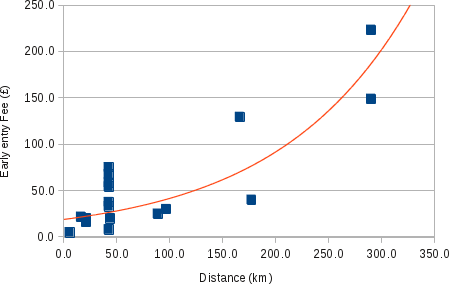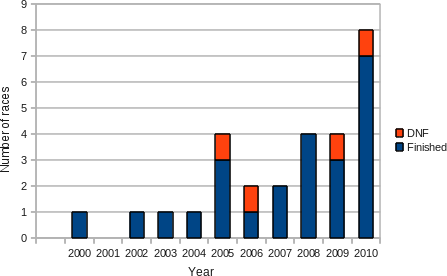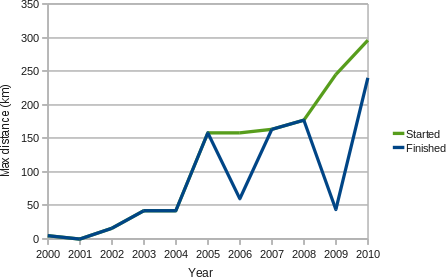Sunday, May 20 2012
Are ultrarunners slow?
By Julien on Sunday, May 20 2012, 21:59 - Thoughts
Ultra slow
Sunday, May 20 2012
By Julien on Sunday, May 20 2012, 21:59 - Thoughts
Thursday, April 26 2012
By Julien on Thursday, April 26 2012, 13:40 - Thoughts
Thursday, April 5 2012
By Julien on Thursday, April 5 2012, 10:16 - Thoughts
Wednesday, March 21 2012
By Julien on Wednesday, March 21 2012, 14:05 - Thoughts
Tuesday, March 13 2012
By Julien on Tuesday, March 13 2012, 21:07 - Thoughts
| Race | Distance | Entry Fee | Fee/distance |
| (km) | (£) | (£/km) | |
| Cambridge Boundary Run | 42.2 | 8.0 | 0.19 |
| Hardmoors 110 | 177.1 | 40.0 | 0.23 |
| Hardmoors 55 | 88.6 | 25.0 | 0.28 |
| Hardmoors 60 | 96.6 | 30.0 | 0.31 |
| Three Forts Marathon | 43.5 | 20.0 | 0.46 |
| PTL (3 runners) | 290.0 | 148.8 | 0.51 |
| UfDance half-marathon | 21.1 | 16.0 | 0.76 |
| PTL (2 runners) | 290.0 | 223.2 | 0.77 |
| UTMB | 166.0 | 129.4 | 0.78 |
| Belfast Marathon | 42.2 | 33.0 | 0.78 |
| Marathon des Alpes-Maritimes | 42.2 | 37.6 | 0.89 |
| Hyde Park Relays (internal) | 5.3 | 5.0 | 0.94 |
| Watford Half-Marathon | 21.1 | 20.0 | 0.95 |
| Paris Marathon | 42.2 | 54.2 | 1.29 |
| Paris-Versailles | 16.0 | 21.7 | 1.36 |
| Dublin Marathon | 42.2 | 58.4 | 1.38 |
| Copenhagen Marathon | 42.2 | 67.4 | 1.60 |
| Athens Marathon | 42.2 | 75.1 | 1.78 |
| Race | Distance | Entry Fee | Fee/distance |
| (km) | (£) | (£/km) | |
| Cambridge Boundary Run | 42.2 | 12.0 | 0.28 |
| Hardmoors 55 | 88.6 | 30.0 | 0.34 |
| Hardmoors 60 | 96.6 | 35.0 | 0.36 |
| Hardmoors 110 | 177.1 | 70.0 | 0.40 |
| PTL (3 runners) | 290.0 | 148.8 | 0.51 |
| Three Forts Marathon | 43.5 | 25.0 | 0.58 |
| PTL (2 runners) | 290.0 | 223.2 | 0.77 |
| UTMB | 166.0 | 129.4 | 0.78 |
| Belfast Marathon | 42.2 | 33.0 | 0.78 |
| Hyde Park Relays (internal) | 5.3 | 5.0 | 0.94 |
| UfDance half-marathon | 21.1 | 20.0 | 0.95 |
| Watford Half-Marathon | 21.1 | 20.0 | 0.95 |
| Marathon des Alpes-Maritimes | 42.2 | 62.6 | 1.48 |
| Copenhagen Marathon | 42.2 | 73.1 | 1.73 |
| Paris-Versailles | 16.0 | 28.4 | 1.77 |
| Dublin Marathon | 42.2 | 75.1 | 1.78 |
| Athens Marathon | 42.2 | 75.1 | 1.78 |
| Paris Marathon | 42.2 | 79.3 | 1.88 |

Monday, January 30 2012
By Julien on Monday, January 30 2012, 10:04 - ThamesSourceQuest
Thursday, May 26 2011
By Julien on Thursday, May 26 2011, 22:54 - Misc
Sunday, March 6 2011
By Julien on Sunday, March 6 2011, 12:18 - Thoughts
3 Forts Marathon (April 2009):I've not trained much
Marathon 06 (November 2009):given my nearly-inexistent training
Hyde Park Relays (February 2010):with a very minimal training!
Thames Source Quest (July 2010):given my current general lack of serious training
PTL (August 2010):without much training...
Marathon 06 (November 2010):given the extremely poor training regime I followed
Hyde Park Relays (February 2011):given my minimal 3-week training plan
given my lack of training


Wednesday, October 20 2010
By Julien on Wednesday, October 20 2010, 19:16 - PTL
Monday, June 14 2010
By Julien on Monday, June 14 2010, 17:35 - Nutrition
Lining up every imaginable energy gel and scrutinising the nutritional fine print isn't unheard of for serious endurance athletes. The table below provides a quick comparison of the critical components of the energy gels most readily available.The table is obviously designed to favour their gels. For example, it seems to show that only GU has caffeine and anti-oxydant. Whilst they are not lying strictly speaking, they are really borderline. For example, the SiS Go, High5 and PowerBar have variations that include caffeine. They might not be sold under the exact same name (SiS Smart1, High5 Plus, PowerGel), but they do exist. They've simply not been considered as "most readily available". And I won't even mention the large number of gels on the market that are not even listed here. Furthermore, the choice of "critical components" is totally arbitrary.
Monday, May 10 2010
By Julien on Monday, May 10 2010, 14:44 - Thoughts
Tuesday, April 20 2010
By Julien on Tuesday, April 20 2010, 16:38 - Thoughts
Friday, March 5 2010
By Julien on Friday, March 5 2010, 14:13 - Nutrition
Wednesday, February 24 2010
By Julien on Wednesday, February 24 2010, 19:03 - UTMB
Thursday, February 11 2010
By Julien on Thursday, February 11 2010, 12:54 - Thoughts
Friday, October 30 2009
By Julien on Friday, October 30 2009, 11:44 - Thoughts
You don't train for a marathon, you just run it!This passage of the scriptures is summarised here.
« previous entries - page 1 of 3